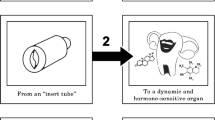Abstract
Background/aim
We investigated the hypothesis that external (EUS) and internal (IUS) urethral sphincters and urinary bladder (UB) respond to penile thrusting (PT) of vagina in a way that prevents urinary leakage during coitus.
Methods
Vaginal condom was inflated with air in increments of 50–300 ml and EMG of EUS and IUS and vaginal pressure were recorded; test was repeated after anesthetization of vagina, UB, EUS, and IUS.
Results
Vaginal distension effected reduction of vesical pressure but increase of IUS EMG until the 150 ml distension was reached, beyond which more vaginal distension caused no further effect; EUS EMG showed no response. Vaginal distension while vagina, UB, EUS, and IUS had been separately anesthetized, produced no change.
Conclusion
Vaginal balloon distension appears to effect vesical relaxation and increased IUS tone. This seems to provide a mechanism to avoid urine leakage during coitus and to occur through a reflex we term ‘vagino-urethrovesical reflex’.


Similar content being viewed by others
References
Bancroft J (1989) The biological basis of human sexuality. In: Bancroft J (ed) Human sexuality and its problems, 2nd edn. Churchill Livingstone, London, p 63
Bell C (1972) Autonomic nervous control of reproduction: circulatory and other factors. Pharmacol Rev 24:657–713
Bors E, Comarr AE (1960) Neurological disturbances of sexual function with special reference to 629 patients with spinal cord injury. Urol Surv 10:191–222
Guyton AC (1997) Female physiology before pregnancy and the female hormones. In: Guyton AC (ed) Human physiology and mechanisms of disease, 6th edn. WB Saunders, Philadelphia, pp 629–639
Hald T, Bradley WE (1982) Neuroanatomy. In: Hald T, Bradley WE (eds) The urinary bladder: neurology and dynamics. Williams and Wilkins, Baltimore, pp 5–21
Janig W, McLachlan EM (1987) Organization of lumbar spinal outflow to the distal colon and pelvic organs. Physiol Rev 67:1332–1404
Janig W (1996) Behavioral and neurovegetative components of reproductive functions. In: Gregor R, Windhorst U (eds) Comprehensive human physiology: from cellular mechanisms to integration, vol 2. Springer, Berlin, pp 2253–2263
Masters WH, Johnson VG (1970) Human sexual inadequacy. In: Masters WH, Johnson VG (eds) Little Brown, Boston
Morris JL, Gibbins IL (1992) Co-transmission and neuromodulation. In: Burnstock G, Hoyle CHV (eds) Autonomic neuroeffector mechanism. Harwood Academic, Chur, Switzerland, pp 33–119
Morrison JFB, Spillane K (1986) Neuropharmacological studies on descendin inhibitory controls over micturition reflex. J Auton Nerv Syst, pp 393–396
Papka RE, Traurig HH (1993) Autonomic efferent and visceral sensory innervation of the female reproductive system: special reference to neurochemical markers in nerves and ganglionic connections. In: Maggi CA (ed) Nervous control of the urogenital system. Harwood Academic, Chur, Switzerland, pp 423–466
Pohl CR, Knobil E (1982) The role of the central nervous system in the control of ovarian function in higher primates. Annu Rev Physiol 44:583–593
Shafik A (1993) The cervico–cavernosus reflex. Description of the reflex and its role in the sexual act. Int Urogynecol J 4:70–73
Shafik A (1993) Vagino–cavernosus reflex. Clinical significance and role in sexual act. Gynecol Obstet Invest 35:114–117
Shafik A (1994) Utero–cervical inhibitory reflex. The description of a reflex and its clinical significance. Human Reprod 9:2220–2223
Shafik A (1995) Vagino-levator reflex: description of a reflex and its role in sexual performance. Eur J Obstet Gynecol Reprod Biol 60:161–164
Shafik A (1995) Vagino–puborectalis reflex. The description of a new reflex and its clinical significance. Int J Gynaecol Obstet 51:61–62
Shafik A (1995) The ‘clitoromotor’ reflex. Int Urogynecol J 6:329–335
Shafik A (1996) The cervico-motor reflex. Description of the reflex and role in sexual act. J Sex Res 33:153–157
Shafik A (1999) A study on the continence mechanism of the external urethral sphincter with identification of the “voluntary urinary inhibition reflex”. J Urol 162:1967–1971
Shafik A, Sibai O (2001) Effect of vaginal distension on vesicourethral function with identification of the vagino–vesicourethral reflex. J Urol 165:887–889
Silva C, Ribeiro ML, Cruz F (2002) The effect of intravesical resininferatoxin in patients with idiopathic detrusor instability suggests that involuntary detrusor contractions are triggered by C-fiber input. J Urol 168:575–579
Steers WD (1998) Physiology and pharmacology of the bladder and urethra. In: Walsh PC, Retik AB, Vaughan ED, Wein AJ (eds) Campbell’s urology, 7th edn. WB Saunders, Philadelphia, pp 870–915
Traurig HH, Papka RE (1993) Autonomic efferent and visceral sensory innervation of the female reproductive system: special reference to the functional roles of nerves in reproductive organs. In: Maggi CA (ed) Nervous control of the urogenital system. Harwood Academic, Chur, Switzerland, pp 103–141
Warwick R, Williams PL (1975) Productive organs of the female. In: Warwick R, Williams PL (eds) Gray’s anatomy, 35th edn. Longman, London, pp 1351–1363
Yokoyama O, Komotso K, Kodama K et al (2000) Diagnostic value of intravesical lidocaine for overactive bladder. J Urol 164:340–343
Acknowledgments
Margot Yehia assisted in preparing the manuscript.
Author information
Authors and Affiliations
Corresponding author
Rights and permissions
About this article
Cite this article
Shafik, A., Shafik, A.A., Shafik, I.A. et al. The electromyographic activity of the external and internal urethral sphincters and urinary bladder on vaginal distension and its role in preventing vaginal soiling with urine during sexual intercourse. Arch Gynecol Obstet 277, 213–217 (2008). https://doi.org/10.1007/s00404-007-0456-8
Received:
Accepted:
Published:
Issue Date:
DOI: https://doi.org/10.1007/s00404-007-0456-8




